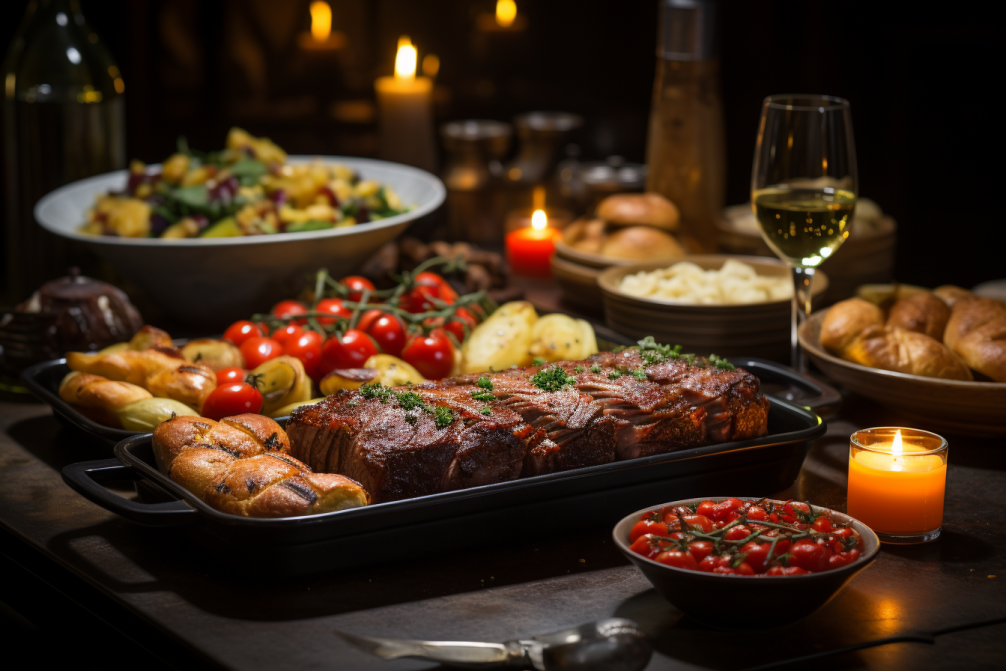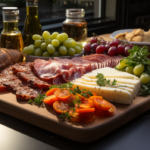Table of Contents
Indulge Your Taste Buds: Unleashing Culinary Creativity at a Gourmet Evening!
Welcome, foodies and cooking enthusiasts, to a fabulous feast for the senses! If you’re a lover of all things culinary, then prepare to elevate your taste buds to new heights with our gourmet evening. Get ready to embark on a gastronomic adventure filled with fun cooking party ideas that will leave your guests begging for seconds.
At this gourmet soirée, it’s all about celebrating the art of cooking and indulging in mouthwatering creations. We’ll guide you through a variety of themes and ideas that will not only showcase your skills in the kitchen but also deliver an unforgettable experience for everyone involved.
Picture this: transforming your kitchen into a bustling culinary oasis, where guests don their chef hats and aprons, ready to master the secrets of gourmet cuisine. From sushi rolling to pasta making, we’ll explore different cooking techniques and recipes that are sure to impress even the most discerning palates.
But it’s not just about the food! Our gourmet evening also brings a sense of fun and camaraderie to the mix. Imagine competing in friendly cook-offs, challenging your friends to create delectable dishes using surprise secret ingredients. Or why not set up a DIY cocktail station, where guests can mix and mingle while sipping on handcrafted libations?
Whether you’re hosting an intimate gathering or a larger gathering, our gourmet evening ideas will inspire you to create a memorable culinary experience that will have your guests talking for years to come. So, grab your favorite chef’s knife, put on your apron, and let’s dive into the world of gourmet cooking together!
Sustainable Dining Experience: Farm-to-Table Delights
Bring the joys of sustainability and farm-to-table dining to your gourmet evening. This eco-friendly and delicious concept allows your foodie guests to connect with nature and savor the freshness of locally sourced ingredients. Here are the essential aspects of a sustainable dining experience:
1. Locally Sourced Ingredients: Explore local farmers markets or artisanal producers to find fresh, seasonal ingredients. Source a variety of vegetables, fruits, meats, cheeses, and other products from nearby farms and suppliers. Highlight the unique flavors and quality of these locally sourced ingredients in your dishes.
2. Menu Planning and Seasonality: Create a menu that reflects the seasonal availability of ingredients. Emphasize the flavors of each season, using produce at its peak ripeness. Incorporate dishes that allow the natural flavors to shine, allowing guests to appreciate the freshness and quality of the ingredients.
3. Sustainable Cooking Techniques: Opt for sustainable cooking techniques that minimize waste and maximize flavor. Consider techniques such as using whole ingredients, preserving excess produce through pickling or fermenting, or making stocks from vegetable scraps. These practices align with the principles of sustainable cooking, reducing food waste and enhancing the overall dining experience.
4. Presentation with Natural Aesthetics: When plating your dishes, embrace natural aesthetics and minimalist presentation. Allow the vibrant colors and organic shapes of the ingredients to shine through. Use sustainable and biodegradable servingware or opt for reusable plates and utensils to minimize waste.
5. Informative Tasting Notes: Provide guests with informative tasting notes that highlight the journey from farm to table. Include details about the local farmers, producers, and sustainable practices employed. Educate your guests on the importance of supporting local communities and the environmental benefits of sustainable dining.
A sustainable dining experience not only offers exquisite flavors but also fosters a sense of connection with the environment and local communities. By incorporating locally sourced ingredients, seasonal menus, sustainable cooking techniques, and informative tasting notes, your foodie guests will appreciate the fresher and more conscious approach to dining. So, embrace the beauty of nature and savor the flavors of a farm-to-table gourmet evening!
Setting the Stage: Transforming Your Kitchen into a Culinary Oasis
When it comes to hosting a gourmet evening for foodies, the first step is to transform your kitchen into a culinary oasis. Creating the right ambiance and setting the stage will enhance the overall experience for your guests. Here are some essential aspects to consider:
1. Ambience and Decor: To set the mood, dim the lights or use soft lighting, and play some ambient background music that complements the theme of the evening. Consider decorating the space with fresh flowers, candles, or stylish table settings to add a touch of elegance and refinement.
2. Organized Workstations: Ensure that your kitchen is well-organized and equipped for a culinary extravaganza. Set up different workstations for specific activities such as chopping, mixing, and plating. Keep all the necessary tools, utensils, and ingredients readily accessible to make the cooking process seamless and enjoyable.
3. Ample Seating and Social Spaces: Create comfortable seating areas where guests can relax, sip their cocktails, and socialize during breaks from the cooking activities. Arrange the space so that it encourages conversation and mingling. Consider providing a cozy lounge area or outdoor seating if space allows.
4. Inspiring Displays: Showcase your culinary skills by displaying some beautifully plated dishes or ingredients as centerpieces. Arrange a visually appealing cheese and charcuterie board or a vibrant fruit display to tantalize guests’ taste buds and ignite their creativity.
5. Interactive Elements: Include interactive elements to engage your guests. Set up a tasting station showcasing different types of olive oils or cheeses for guests to sample and compare. Offer small bites or hors d’oeuvres that guests can enjoy while exploring the kitchen or waiting for their turn at the cooking stations.
6. Personalized Touches: Add personal touches that reflect your own style and personality. Create custom name cards for each guest, design menu cards with unique descriptions of the dishes, or provide small favors related to the culinary theme.
Setting the stage and transforming your kitchen into a culinary oasis will elevate the overall experience of your gourmet evening. With the right ambiance, organization, and personal touches, you’ll create an inviting and inspiring environment that will leave a lasting impression on your foodie guests.
Mastering the Art of Sushi Rolling: A Fun and Flavorful Activity
One of the most exciting activities to include in your gourmet evening for foodies is mastering the art of sushi rolling. This hands-on experience not only allows guests to create their own delectable sushi rolls but also provides an opportunity to explore different flavors and combinations. Here are some essential aspects to consider:
1. Sushi Ingredients and Tools: Make sure to gather an array of sushi ingredients such as fresh fish, vegetables like cucumber and avocado, pickled ginger, wasabi, and nori seaweed sheets. Don’t forget to have sushi rice seasoned with vinegar and sushi rolling mats ready. Provide guests with all the necessary tools required for sushi rolling, such as sharp knives, bamboo mats, and bowls of water for hand-dipping.
2. Sushi Rolling Demonstration: Start the activity by showcasing a sushi rolling demonstration. Share tips and techniques on how to properly roll and shape sushi. Explain the importance of rice consistency, ingredient placement, and the art of tight rolling. This demonstration will give guests an idea of what to aim for when it’s their turn to roll.
3. Ingredient Selection and Customization: Set up a sushi bar with an assortment of ingredients, allowing guests to customize their rolls according to their preferences. Display colorful ingredients in an organized and visually appealing manner, encouraging guests to mix and match flavors and create unique combinations. Offer a variety of vegetarian and non-vegetarian options to cater to different dietary preferences.
4. Sushi Rolling Stations: Create designated sushi rolling stations where guests can gather around and showcase their sushi rolling skills. Provide each station with a bamboo mat, nori sheets, rice, and a selection of ingredients. Encourage guests to experiment with different fillings and rolling techniques, and offer assistance or guidance as needed.
5. Sushi Tasting and Presentation: Once the guests have rolled their sushi masterpieces, set up a dedicated area for guests to display their creations and share their accomplishments. Encourage everyone to try each other’s sushi rolls, fostering a sense of camaraderie and celebration of culinary creations. Don’t forget to provide soy sauce, wasabi, and pickled ginger for guests to use as accompaniments.
Mastering the art of sushi rolling is not only a fun and interactive activity but also allows guests to unleash their creativity and explore new flavor combinations. With the right ingredients, tools, and guidance, your guests will have a blast rolling their own sushi masterpieces and indulging in a delightful culinary experience during your gourmet evening.
Pasta Party Extravaganza: Handmade Noodles and Delicious Sauces
If you’re looking to take your gourmet evening to the next level, a pasta party extravaganza is just the thing to satisfy your foodie guests. This activity allows them to dive into the world of handmade noodles and delectable sauces. Here are the essential aspects to consider:
1. Pasta Making Supplies: Gather the necessary pasta making supplies such as flour, eggs, salt, and olive oil. Provide ample workspace for guests to knead and roll out their pasta dough. Have pasta machines or rolling pins available for those who prefer a traditional approach.
2. Pasta Making Demonstration: Begin the pasta party extravaganza with a demonstration on how to make pasta from scratch. Show guests the process of combining ingredients, kneading the dough, and rolling it into thin sheets. Explain different pasta shapes and techniques, like creating ravioli or fettuccine noodles. This demonstration will inspire and guide guests in their pasta making journey.
3. Sauce Stations: Set up various stations where guests can choose, customize, and prepare their own pasta sauces. Offer a range of options, including classic favorites like tomato and basil, creamy Alfredo, or a rich Bolognese. Provide an array of ingredients such as fresh herbs, garlic, grated cheese, and a selection of vegetables or proteins to enhance the sauce flavors.
4. Pasta Cooking and Pairing: Once the pasta is rolled and cut, provide large pots of well-salted boiling water for guests to cook their handmade noodles. Educate them on the ideal cooking time for each type of pasta and emphasize the importance of a perfectly al dente texture. Pair the cooked pasta with the respective sauces to create mouthwatering combinations.
5. Tasting and Sharing: Encourage guests to taste each other’s creations and share their experiences. Create a communal dining area where everyone can gather and enjoy the fruits of their labor. Provide additional toppings such as grated Parmesan, fresh herbs, and drizzles of high-quality olive oil for guests to personalize and enhance their dishes.
A pasta party extravaganza brings the joy of handmade pasta and exquisite sauces to your gourmet evening. With guidance, creativity, and a shared appreciation for culinary delights, your foodie guests will immerse themselves in the art of pasta making, creating memorable dishes that will not only delight their palates but also nourish their souls.
Cook-Off Challenge: Compete with Friends Using Surprise Ingredients
Spice up your gourmet evening by hosting a thrilling cook-off challenge that will ignite your guests’ competitive spirit. This activity will not only test their culinary prowess but also inspire creative thinking and innovation. Here are the essential aspects of a cook-off challenge:
1. Team Formation: Divide your guests into teams, ensuring a good mix of cooking enthusiasts and beginners in each group. This allows for collaboration and promotes a sense of friendly competition.
2. Surprise Ingredients: The key element of a cook-off challenge is the surprise ingredient. Choose unique and unexpected ingredients that will challenge the teams’ culinary skills and imagination. Consider using mystery baskets with hidden ingredients or select a unique ingredient that must be incorporated into each dish.
3. Time Limit: Set a time limit for the cook-off challenge to add excitement and intensity to the competition. Depending on the complexity of the dishes, set a reasonable time frame that pushes the teams to work efficiently while still allowing them to showcase their skills.
4. Judging Panel: Appoint a judging panel consisting of food enthusiasts, chefs, or even other guests. The panel should evaluate the dishes based on taste, presentation, creativity, and use of the surprise ingredient.
5. Prizes and Rewards: Motivate the teams by offering prizes for the winners. Consider awarding categories such as “Best Presentation,” “Most Creative Use of Surprise Ingredient,” or “Overall Winner.” The prizes can be culinary-related items, personalized certificates, or even a small trophy.
6. Tasting and Celebration: After the time is up, have each team present their dishes to the judging panel. Encourage all guests to taste and appreciate the culinary creations. Celebrate the efforts and accomplishments of the teams, creating a festive environment full of laughter and delicious food.
A cook-off challenge adds an element of excitement and friendly competition to your gourmet evening. It pushes guests to think outside the box, experiment with new flavors, and showcase their culinary skills. With surprise ingredients, time limits, and a judging panel, this activity creates a memorable experience filled with laughter, camaraderie, and mouthwatering dishes.
Mix and Mingle: Setting Up a DIY Cocktail Station
For an interactive and fun twist at your gourmet evening, create a DIY cocktail station where your foodie guests can unleash their mixology skills and create their own signature drinks. It’s a fantastic way to encourage mingling, socializing, and exploring unique flavor combinations. Here’s how to set up a fabulous DIY cocktail station:
1. Spirits and Mixers: Stock your DIY cocktail station with a variety of spirits such as vodka, rum, gin, and tequila. Offer an assortment of mixers like soda, tonic water, fruit juices, and flavored syrups. Ensure a good selection of bitters, herbs, and fresh fruits to add depth and interest to the cocktails.
2. Glassware and Bar Tools: Provide a range of glassware options, including highball glasses, martini glasses, and old-fashioned glasses. Lay out all the necessary bar tools such as shakers, strainers, muddlers, jiggers, and bar spoons. Make sure to have plenty of ice on hand for shaking, stirring, and chilling the cocktails.
3. Garnishes and Flair: Elevate the visual appeal of the cocktails by offering an array of garnishes, such as citrus twists, fresh herbs, colorful fruit wedges, and edible flowers. Provide rimming options like salt, sugar, or flavored salts. Additionally, consider adding fun and decorative flair like cocktail skewers, drink umbrellas, or personalized stirrers for a festive touch.
4. Recipe Cards and Inspirations: Display recipe cards with a few classic cocktail recipes to get your guests started. Include some popular concoctions like mojitos, margaritas, cosmopolitans, and martinis. Provide creative and inspiring flavor combinations, encouraging guests to experiment and create their own signature drinks. You may also want to display a ‘cocktail of the night’ for guests to try.
5. Personalization Station: Set up a personalization station where guests can label their drinks with fun and creative names. Provide tags, pens, or small chalkboards for guests to write their names or create quirky cocktail monikers.
Setting up a DIY cocktail station adds an element of excitement, creativity, and personalization to your gourmet evening. It empowers guests to become their own mixologists, creating unique flavor combinations and sharing their favorite concoctions with others. With an array of spirits, mixers, garnishes, and inspiration, your foodie guests will have a blast shaking, stirring, and sipping their way to cocktail perfection. Cheers to a memorable and tasty evening!
Elevate Your Palate: Exploring Exotic Ingredients and Flavors
For a gourmet evening that leaves a lasting impression on your foodie guests, consider incorporating exotic ingredients and flavors into your culinary creations. This aspect of the event will not only elevate their palates but also provide a unique and memorable dining experience. Here’s how to explore exotic ingredients and flavors at your gourmet evening:
1. Research and Sourcing: Begin by researching exotic ingredients that pique your interest. Dive into the world of rare spices, unique fruits, unusual vegetables, and lesser-known herbs. Once you have your list, explore local specialty stores, international markets, or online suppliers to source these ingredients.
2. Exotic Ingredient Showcase: Create an exotic ingredient showcase by displaying your curated collection for guests to see and learn about. Provide descriptions, origins, and interesting facts about each ingredient. This will pique their curiosity and inspire them to experiment with new flavors.
3. Interactive Cooking Stations: Set up interactive cooking stations where guests can explore and use these exotic ingredients. Offer stations dedicated to specific ingredients or cuisines, such as a saffron-infused paella station, a Moroccan spice blending station, or a tropical fruit tasting station. Provide recipes, guidance, and assistance to help guests make the most of these unique ingredients.
4. Flavor Pairings and Tasting Notes: Provide flavor pairing suggestions and tasting notes for the exotic ingredients. Share tips on how to balance flavors, create harmonious combinations, and enhance the overall dining experience. Encourage guests to experiment and create their own flavor profiles using the exotic ingredients.
5. Menu Innovation and Fusion: Challenge guests to use the exotic ingredients in innovative and creative ways. Encourage them to infuse the flavors into traditional dishes or experiment with fusion concepts. This allows guests to push their culinary boundaries and experience the thrill of exploring new taste sensations.
By exploring exotic ingredients and flavors, you invite your foodie guests to venture into new culinary territories. Whether it’s the vibrant hues of unique spices, the intriguing aromas of unusual herbs, or the surprising tastes of exotic fruits, each dish becomes an adventure for the palate. So, let your creativity soar as you introduce these extraordinary flavors and elevate your gourmet evening to new heights.
Dessert Delights: Tempting Treats to Satisfy Your Sweet Tooth
No gourmet evening is complete without indulging in a delectable selection of desserts. Treat your foodie guests to a mouthwatering array of tempting treats that will satisfy their sweet tooth and leave them craving for more. Here are the essential aspects of creating dessert delights at your gourmet evening:
1. Miniature Pastries and Petit Fours: Create an assortment of miniature pastries and petit fours that offer a variety of flavors and textures. Think bite-sized eclairs, macarons, cream puffs, and delicate tarts. The smaller portions allow guests to sample multiple treats without feeling overwhelmed.
2. Gourmet Chocolates and Truffles: Elevate your dessert spread by including a selection of gourmet chocolates and truffles. Opt for unique flavors like sea salt caramel, matcha green tea, or dark chocolate with raspberry ganache. Arrange them beautifully on a platter or in elegant boxes for an irresistible presentation.
3. Artisanal Desserts: Showcase artisanal desserts that are handmade with love and attention to detail. Think about creamy panna cotta with a berry coulis, silky chocolate mousse, or delicate fruit tarts with a buttery crust. These artisanal creations exude sophistication and are sure to impress your foodie guests.
4. Dessert Wine Pairing: Enhance the dessert experience by offering dessert wine pairings that complement the flavors and intensify the enjoyment. Provide a selection of sweet wines like Sauternes, Moscato d’Asti, or late-harvest Riesling. Educate your guests on the flavor profiles and suggest pairings with specific desserts.
5. Refreshing Tea and Coffee: Pair your desserts with a selection of refreshing teas and specialty coffees. Offer different varieties such as herbal teas, fragrant green teas, or robust espresso. These hot beverages provide a balance to the sweetness and enhance the overall dessert tasting experience.
6. Interactive Dessert Stations: Set up interactive dessert stations where guests can participate in the preparation or customization of their treats. For example, a DIY sundae bar with various toppings, a crepe station with a selection of fillings, or a dessert fondue station with melted chocolate and an array of dipping options.
Dessert delights are an essential component of a gourmet evening, satisfying the sweet tooth and providing a delightful finale to the dining experience. With miniature pastries, gourmet chocolates, artisanal desserts, and thoughtful wine and beverage pairings, your foodie guests will be wowed by the tantalizing array of treats. So, let their taste buds dance with joy as they indulge in these tempting desserts!
Food Pairing Magic: Creating Perfect Combinations
One of the most intriguing aspects of a gourmet evening is the art of food pairing. Unlock the magic of perfect flavor combinations by exploring the harmony between different ingredients and dishes. Here are the essential aspects of creating food pairing magic at your foodie gathering:
1. Complementary Flavors: Understand the concept of complementary flavors and how certain ingredients can enhance and balance each other. Consider pairing sweet and savory, spicy and cooling, or rich and acidic flavors. For example, the sweetness of caramelized onions complements the tanginess of goat cheese, creating a delightful contrast.
2. Interplay of Textures: Experiment with the interplay of textures to create exciting and harmonious combinations. Pair crispy with creamy, smooth with crunchy, or velvety with chewy. For instance, a creamy vanilla panna cotta with a crunchy caramelized sugar topping offers a delightful textural contrast.
3. Contrasting Colors: Visual appeal is an important aspect of food pairing. Play with contrasting colors to make your dishes visually striking. Pair vibrant green vegetables with rich red sauces, or create a monochromatic plate using different shades of a single color. The contrast adds excitement and interest.
4. Wine and Food Pairing: Don’t forget to explore the world of wine and food pairing. Different wines can enhance the flavors of specific dishes and create amazing taste experiences. Consider the body, acidity, and characteristics of a wine, and pair it with complementary flavors in the dish. For example, a crisp Sauvignon Blanc can complement seafood or fresh salads.
5. Regional and Global Pairings: Experiment with regional or global pairings to expand your culinary horizons. Explore the traditional flavor combinations of specific cuisines and use them as inspiration. Pair Italian pasta with the complementary flavors of Mediterranean ingredients, or combine the aromatic spices of Indian cuisine with cooling yogurt-based sauces.
When creating food pairing magic, let your creativity soar. Discover the wonders of complementary flavors, textures, colors, and global inspirations. Combine the artistry of the culinary world with a touch of experimentation, and watch as your foodie guests embark on an unforgettable taste journey. Cheers to the magic of perfect combinations!
The Art of Plating: Presenting Your Dishes with Style
In the world of gourmet cuisine, the way a dish is presented can be just as important as its flavors. Elevate your gourmet evening by mastering the art of plating, turning each dish into a work of art. Here are the essential aspects of presenting your dishes with style:
1. Visual Appeal: Enhance the visual appeal of your dishes by utilizing color, texture, and symmetry. Consider incorporating vibrant fruits or vegetables, contrasting sauces, or garnishes that add a pop of color. Play with textures by balancing crispy elements with creamy ones. Aim for a visually balanced plate, where each component has its place.
2. Plate Selection: Choose the right plate for each dish, considering the size, shape, and color. Some dishes may benefit from a simple white plate to let the colors and textures shine, while others may call for a more unique or elegant presentation vessel. Use various shapes and sizes to add visual interest and showcase the food.
3. Layering and Stacking: Create visual depth and interest by layering or stacking components of the dish. For example, arrange slices of roasted vegetables in a fan shape, layer alternating colors of sauce, or stack seafood and garnish to give height to the plate. This adds dimension and captures attention.
4. Negative Space: Embrace the power of negative space on the plate. Leave room between different components to create a sense of balance and focus. Negative space allows the eye to appreciate each element and adds a touch of elegance to the presentation.
5. Artful Garnishes: Elevate your plating game with artful garnishes. Use herbs, edible flowers, microgreens, or citrus zest to add a burst of freshness and visual appeal. Garnishes should complement the flavors and colors of the dish while adding an exquisite finishing touch.
6. Sauces and Drizzles: Master the art of sauce placement and drizzling. Use squeeze bottles or spoons to create elegant swirls, dots, or lines on the plate. These artistic touches add finesse and bring focus to the main ingredients.
The art of plating allows you to express your creativity and make a lasting impression on your foodie guests. By considering visual appeal, plate selection, layering, negative space, garnishes, and sauces, you’ll transform each dish into a visual masterpiece. So, let your imagination run wild and present your culinary creations with style and finesse at your gourmet evening.
Wine Tasting Soirée: Discovering the Perfect Pairings
A wine tasting soirée is an essential element of any gourmet evening for foodies. It provides a unique opportunity to explore the nuances of different wines while discovering the perfect pairings with your culinary creations. Here are the essential aspects of hosting a wine tasting soirée:
1. Wine Selection: Curate a selection of wines that showcases a variety of flavors and styles. Include red, white, and rosé wines from different regions or grape varieties. Offer a range of sweetness levels, ranging from dry to sweet, to accommodate different palates.
2. Tasting Flight Experience: Set up a tasting flight experience where guests can sample multiple wines. Provide tasting notes and background information on each wine, including its origin, producer, and tasting profile. Encourage guests to take their time, observing the color, aromas, and flavors of each wine.
3. Food and Wine Pairings: Pair each wine in the tasting flight with complementary dishes. Consider the flavor profiles of both the wine and the dish to create harmonious combinations. For example, pair a full-bodied red wine with rich meats or a crisp white wine with seafood or light appetizers. Provide guidance on pairing suggestions to enhance the tasting experience.
4. Tasting Notes and Discussions: Give guests the opportunity to make tasting notes and discuss their impressions. Provide tasting sheets with space for guests to jot down their observations, such as aroma, acidity, body, and finish. Encourage discussion and exchange of opinions, as it adds to the interactive and educational nature of the soirée.
5. Wine Education: Offer a brief introduction to the basic concepts of wine appreciation, including wine regions, grapes, and production methods. Share insights about the different wine characteristics, such as tannins, acidity, and aging potential. This helps guests develop a deeper understanding and appreciation for the wines they are tasting.
A wine tasting soirée brings a touch of sophistication and curiosity to your gourmet evening. It allows guests to explore the world of wine while discovering how different flavors and textures can enhance the wine tasting experience. So, raise a glass, savor the flavors, and embark on a captivating journey of wine and culinary pleasure!
Conclusion
In conclusion, a gourmet evening filled with fun cooking party ideas is the perfect way to satisfy the foodie within you. From exploring global cuisines to mastering the art of plating, each aspect adds a special touch to elevate your culinary experience. Whether you’re rolling sushi, creating personalized cocktails, or indulging in delectable desserts, these activities bring joy and creativity to the table.
The beauty of a gourmet evening lies in the opportunity to connect with friends and loved ones over a shared love for food. It’s a chance to bond, laugh, and create lasting memories while savoring the flavors of carefully crafted dishes.
By embracing themes, competitions, and interactive stations, you can turn your kitchen into a culinary oasis. The journey from farm to table or the exploration of exotic ingredients can open your palate to new tastes and cultural experiences.
So, let your taste buds rejoice and your creativity run wild. With these fun cooking party ideas, you’ll create an unforgettable gourmet evening that will leave your foodie guests begging for more. Happy cooking and bon appétit!









